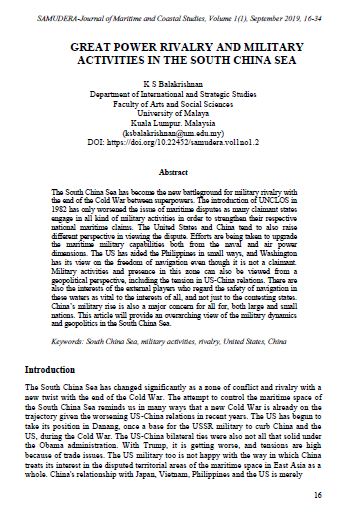GREAT POWER RIVALRY AND MILITARY ACTIVITIES IN THE SOUTH CHINA SEA
Main Article Content
Abstract
The South China Sea has become the new battleground for military rivalry with the end of the Cold War between superpowers. The introduction of UNCLOS in 1982 has only worsened the issue of maritime disputes as many claimant states engage in all kind of military activities in order to strengthen their respective national maritime claims. The United States and China tend to also raise different perspective in viewing the dispute. Efforts are being taken to upgrade the maritime military capabilities both from the naval and air power dimensions. The US has aided the Philippines in small ways, and Washington has its view on the freedom of navigation even though it is not a claimant. Military activities and presence in this zone can also be viewed from a geopolitical perspective, including the tension in US-China relations. There are also the interests of the external players who regard the safety of navigation in these waters as vital to the interests of all, and not just to the contesting states. China’s military rise is also a major concern for all for, both large and small nations. This article will provide an overarching view of the military dynamics and geopolitics in the South China Sea.
Keywords: South China Sea, military activities, rivalry, United States, China
Downloads
Article Details
References
Substantial reasons or exaggeration? In E. Kok & Joanne (eds.), China in the
world: Contemporary issues and perspectives (pp. 17-28). Kuala Lumpur:
Institute of China Studies, University of Malaya.
Bateman, S. (2010, August 16). The South China Sea: When the elephants dance. RSIS
Commentary.
Bergin, A. (1983, September). Navigating the Montego Bay Convention: Implications
for navy and naval convention. Asian Defence Journal.
Cushing, J. (1988, May 5). The dragon’s long reach. Far Eastern Economic.
Cossa, R. (2010, August 23). China’s expanding coastal waters. PacNet.
Far Eastern Economic Review (1990, April 12). The US ponders other regional
alternatives.
Hassan, M. J. (2010, August 9). Calming the waters in the South China Sea. New
Straits Times.
Hayton B. (2014), The South China Sea: The Struggle for Power in Asia, New haven:
Yale University Press.
Ji, G. (2004, July 8). US RMSI contravenes UN convention on the law of sea, PacNet
29.
King Jr, N. (2007, August 23). Sea resistance to sea treaty breaks down. The Wall Street
Journal.
Lim, R. (2005, August 26-28). China’s muddled maritime strategy. The Asian Wall
Street Journal.
Muller, D. G. (1984). China as a maritime power. Boulder: Westview Press.
New Straits Times (2007, November 11). China’s submarines pops up out of nowhere.
News Straits Times.
New Straits Times (2010a, April 9). US: Dispatch of Chinese Submarines to the
Spratlys not a threat. New Straits Times.
New Straits Times (2010b, July 31). China criticises the US over island chains. New
Straits Times.
New Straits Times (2010c, August 11). US-Vietnam display military ties. New Straits
Times.
New Straits Times (2010d, September 13). China pressure Japan to free crew. New
Straits Times.
New Straits Times (2010e, September 14). Japan free 14 fishermen. New Straits Times.
Roberts, D., & Clifford, M. L. (2001, December 24). Hungry for energy. Business
Week.
Shie, T. R. (2004, October 15). Ships and terrorists-Thinking beyond port security.
PacNet Newsletter.
Simon, S. W. (1991). China and Southeast Asia: Suspicion and hope. Journal of East
Asian Affairs, 5(1), Winter/Spring 1991.
Spurr, R. (1984, November 23). Passive Defence. Asia Week.
Talib, Z. (1992, November 25). US stand on Spratlys issue. The Star.
Valencia, M. J. (1995). China and the South China Sea disputes. Adelphi Papers No.
298. London: Institute of International and Strategic Studies.
Valencia, M. J. (2004). The regime of military and intelligence gathering activities in
the EEZ: Consensus and disagreement. MIMA Bulletin, 1(1), pp. 21-23.
Valencia, M. J. (2006, September 15). The East China Sea dispute: Ways forward.
PacNet 47.
Wortzel, L. (2009, November 2). China’s cyber offensive. The Asian Wall Street
Journal.
